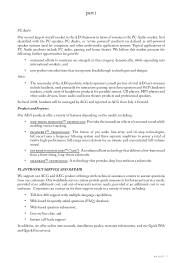Plantronics 2007 Annual Report Download - page 21
Download and view the complete annual report
Please find page 21 of the 2007 Plantronics annual report below. You can navigate through the pages in the report by either clicking on the pages listed below, or by using the keyword search tool below to find specific information within the annual report.
part i
17A R 2 0 0 7
• Because we have significant manufacturing operations in Mexico and China, fluctuations in
currency exchange rates in those two countries can impact our gross profit and profitability.
Fluctuations in our operating results may cause volatility in the trading price of our common stock. For
example, in the second and fourth quarters of fiscal year 2006 and the first quarter of fiscal year 2007, our
operating results either did not meet our targets or the market’s expectations, which had a significant
adverse effect on the trading price of our common stock.
If we do not match production to demand, we may lose business or our gross margins could be materially
adversely affected.
Our industry is characterized by rapid technological change, frequent new product introductions, short-
term customer commitments and rapid changes in demand. We determine production levels based on our
forecasts of demand for our products. Actual demand for our products depends on many factors, which
makes it difficult to forecast. We have experienced differences between our actual and our forecasted
demand in the past and expect differences to arise in the future. Significant unanticipated fluctuations in
demand and the global trend towards consignment of products could cause the following operating
problems, among others:
• If forecasted demand does not develop, we could have excess inventory and excess capacity. Over-
forecast of demand could result in higher inventories of finished products, components and
sub-assemblies. In addition, because our retail customers have pronounced seasonality, we must
build inventory well in advance of the December quarter in order to stock up for the anticipated
future demand. If we were unable to sell these inventories, we would have to write off some or
all of our inventories of excess products and unusable components and sub-assemblies. Excess
manufacturing capacity could lead to higher production costs and lower margins;
• If demand increases beyond that forecasted, we would have to rapidly increase production. We
currently depend on suppliers to provide additional volumes of components and sub-assemblies,
and we are experiencing greater dependence on single source suppliers; therefore, we might not
be able to increase production rapidly enough to meet unexpected demand. This could cause
us to fail to meet customer expectations. There could be short-term losses of sales while we are
trying to increase production. If customers turn to our competitors to meet their needs, there
could be a long-term impact on our revenues and profitability;
• Rapid increases in production levels to meet unanticipated demand could result in higher costs
for components and sub-assemblies, increased expenditures for freight to expedite delivery of
required materials, and higher overtime costs and other expenses. These higher expenditures
could lower our profit margins. Further, if production is increased rapidly, there may be decreased
manufacturing yields, which may also lower our margins;
• The introduction of Bluetooth and other wireless headsets presents many significant
manufacturing, marketing and other operational risks and uncertainties:
° developing and marketing these wireless headset products;
° unforeseen delays or difficulties in introducing and achieving volume production of such
products, as occurred in our second and third quarter of fiscal 2006;
° our dependence on third parties to supply key components, many of which have long lead
times;
° our ability to forecast demand for this new product category for which relevant data is
incomplete or unavailable; and
° longer lead times with certain suppliers than commitments from some of our customers.
























